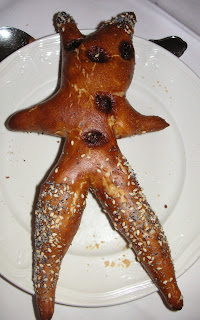
A little while back I remember posting a teaser photo of a dessert I was working on for Christmas – well this is it! It’s a raspberry jelly with vanilla panna cotta. In my family we either don’t like Christmas pud or at that age where it “sits on you” when you’re trying to sleep at night. So I picked this as a light and fruity (but still calorific – don’t fret!) alternative.
Using the gorgeous copper mould Mr CC bought me for Christmas last year I set about making the jelly. Here it is setting in the fridge:
The recipe needs to be started 2 days before serving as you must ensure you’ve left enough time for both layers to set. If you don’t have that much time you could make exactly the same thing in individual moulds and these will set quicker.
It’s by no means a cheap dessert – the raspberries are expensive and all that dairy for the panna cotta isn’t exactly pennies but, for a celebration, it’s worth it. If you consider the price of a good quality dessert from a top food retailer (such as M&S or Waitrose etc) it’s comparable and you know exactly what’s gone into yours – all good stuff! Plus, it’s very rich so serves lots of people.
Homemade jelly is divine; it’s soft and intensely fruity. It’s also a lot less sweet than packet jelly so the fruit really shines through. One thing I would like to point out and I’m sure a science boffin can explain the answer, the liquid jelly mix tastes much sweeter than when it’s set. First time I made this I panicked that it was going to be too sweet so don’t worry if you think the same...it will all be fine!
The fruit in the pan looks glorious; an explosion of colour:
Simmer until it breaks down:
The key to a nice jelly texture is straining out all the fruit seeds. I used a metal sieve – what’s gathering in the bowl is the basis of the jelly:
A piece of equipment I find particularly useful is a straining mushroom. It drives the juice through the sieve. It looks like a darning mushroom (does anyone still use those?) and, when I bought it, I didn’t think I’d ever use it – it’s so effective though, that I use it whenever I sieve fruit:
I love the crisp line where jelly meets panna cotta; it’s important to let the jelly set fully before pouring over the panna cotta otherwise you won’t get this crisp delineation.
Ingredients
Note – this is the basic quantity for the jelly – you can scale it up as required but allow extra setting time. For my giant mould I doubled up the quantities.
5 leaves gelatine
500g raspberries – fresh or frozen, plus an extra punnet to set in the jelly
150g caster sugar
400ml cold water
For the panna cotta recipe click here
Method
Start by soaking the gelatine leaves in cold water until they are soft.
Place the raspberries, sugar and water in a saucepan and heat gently until the sugar has dissolved.
Simmer further and mash the raspberries with a spoon or – and I found this really productive – the masher you’d use to make mash potato.
Pass through a sieve and return the liquid to a clean pan.
Heat gently and then remove the pan from the heat.
Squeeze all the water from the gelatine and whisk into the raspberry juice – it will dissolve very quickly.
Leave the jelly to cool a little.
Pass through a sieve into your chosen mould – sieving again will strain out any seeds that passed through first time.
Drop the extra raspberries into the jelly.
Chill until set – I left overnight.
Now make the panna cotta - for the panna cotta method click here
Pour the panna cotta over the set jelly and press a sheet of clingfilm onto the panna cotta – this stops a skin forming.
Refrigerate overnight to ensure it has set.
To turn out of the mould, dip for 5-10 seconds in warm water then press a plate against the mould and flip. You will hear a release squelch when the jelly has freed itself.
Bask in the glory of the wonderful thing you have made.
Eat.


























































